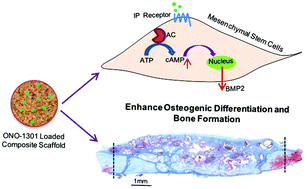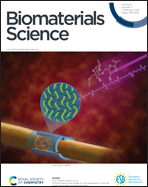ONO-1301 loaded nanocomposite scaffolds modulate cAMP mediated signaling and induce new bone formation in critical sized bone defect†
Abstract
Recent studies on bone regeneration demonstrate the use of low cost and stable small molecules, which avoid the adverse effect and high cost of growth factors. Herein, we investigate the chemotactic, angiogenic and osteoinductive potential of a prostacyclin analogue, ONO-1301, when delivered through a biomimetic nanocomposite scaffold (nanohydroxyapatite–gelatin matrix reinforced with fibers) for bone tissue regeneration. The small molecule was loaded onto the scaffold in three different concentrations. There was burst release from all the groups of scaffolds within 24 h followed by a sustained release up to 14 days, but the concentration was dependent on loading percentage. ONO-1301 loaded scaffolds augmented the migration, proliferation and osteogenic differentiation of mesenchymal stem cells (MSCs), but increasing the concentration beyond a certain dose did not show any effect. The osteoinduction was mediated through the prostaglandin I2 receptor and cyclic AMP (cAMP) signaling pathway. They also promoted new bone formation in large sized calvarial defects in rats compared to the scaffold alone, but did not show any impact on angiogenesis. Hence, this study suggests the chemotactic and osteoinductive capability of ONO-1301 for the repair and regeneration of critical sized bone defects.



 Please wait while we load your content...
Please wait while we load your content...